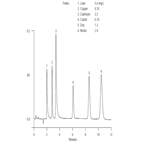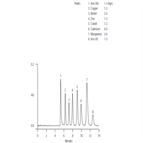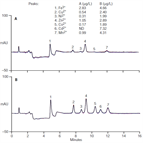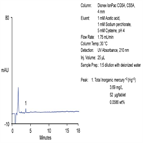Find methods for your needs
Refine by Feature
Displaying 1-5 of 7 results for Tag: IonPac CS5A
TN10: Determination of Transition Metals by Ion Chromatography Using Oxalate Buffer Eluent
Instrument Type: ICThe IonPac CS5A column has both cation and anion exchange capacity, allowing metals to be separated as cations or anions on a single column. This is called a mixed mode separation.Transition metals are separated as both cationic and anionic complexes with the oxalate chelating agent added to the eluent.The metals are detected by measuring the absorbance at 530 nm of the complex formed with the postcolumn PAR reagent.
TN10: Determination of Transition Metals by Ion Chromatography Using PDCA Eluent
Instrument Type: ICThe IonPac CS5A column has both cation and anion exchange capacity, allowing metals to be separated as cations or anions on a single column. This is called a mixed mode separation.Transition metals are separated as anionic complexes with the PDCA chelating agent added to the eluent. The metals are detected by measuring the absorbance at 530 nm of the complex formed with the postcolumn PAR reagent.
AU168: Determination of Transition Metals in Complex Matrices
Instrument Type: ICChelation ion chromatography facilitates the determination of low concentrations (μg/L and lower) of transition metals in samples including seawater, brines, estuarine waters, and a variety of biological samples. Here, the authors simplify the system configuration described in Technical Note 25, using an ICS-3000 system. The separation has also been updated to include the IonPac CS5A/CG5A column set, which demonstrates improved selectivity and peak efficiency for separation of transition metals compared to the CS5.
AN43130: Combining the Synergies of Ion Chromatography and Inductively Coupled Plasma to Identify Mercury Contamination in Herbal Medicines
Instrument Type: ICHerbal medicines containing high total mercury concentrations were previously identified (ICP-MS) as the possible cause of several cases of accidental mercury poisoning. Because mercury species have very different toxicities, speciation analysis is needed to determine the patients’ treatment. Here inorganic and organic mercury ions are separated by IC using a mixed eluent (1.0 mM acetic acid, 1 mM sodium perchlorate, 5 mM cysteine, pH = 4.0) on an IonPac CS5A mixed cation-anion-exchange column. The eluting species are detected and quantified by absorbance at 210 nm.
AN108:Determination of Transition Metals in Serum and Whole Blood by Ion Chromatography
Instrument Type: ICThe determination of transition metals in physiological fluids is of considerable interest in clinical chemistry. This application note describes an attractive alternative to traditional spectroscopic methods by using the principles of ion exchange. Separation between individual metals can be enhanced or altered simply by changing eluents (pyridine-2, 6-dicarboxylic acid or oxalic acid). This figure illustrates the selectivity on an IonPac CS5A column when using a pyridine-2, 6-dicarboxylic acid eluent.





